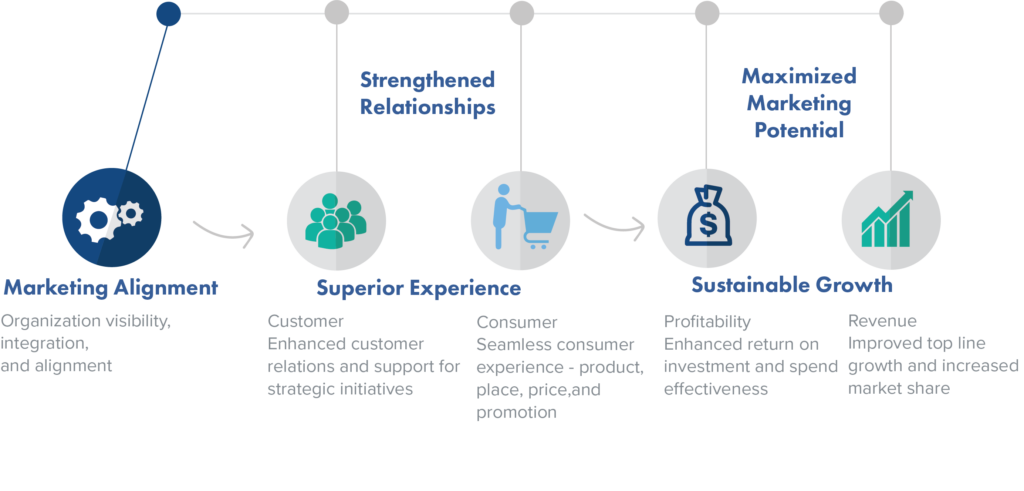Since Jinan Liu’s Fine Needle Shop created the first printed ad in 10th-century China, sellers and marketers have been working together to close deals and grow businesses.
Today, sales and marketing alignment is complicated. Ensuring that these two groups work together is vital to business growth. And while there are barriers to alignment, the process of uniting these traditionally independent teams around a shared set of goals is foundational to success in our digital economy. Modern alignment is a truly interactive process – not a final destination – that requires executive buy-in, shared goals, platforms, and processes to support collaborative initiatives.
However, when only 8% of marketing and sales teams say that they are tightly aligned, achieving this is often easier said than done.
A lack of alignment can be frustrating for a number of reasons. Most professionals prefer the smoother processes and more supportive culture that alignment delivers. But alignment provides much more than a positive work environment. Companies with strong alignment perform better, reporting 36% higher customer retention rates and 38% higher sales win rates.
 Image credit: Clarkson Consulting
Image credit: Clarkson Consulting
Recognising the weight of the problem, businesses are hungry for insight. That’s why we sat down with three people who bridge the sales-marketing gap on a daily basis.
Alignment Starts at the Top
After gaining experience at large, complex enterprises like Adobe and Microsoft, Highspot CMO Jon Perera knows what it takes to bring disparate teams to market together.
According to Jon, “Preconceived notions about sales and marketing often come from deeply embedded assumptions in company culture – therefore, it’s no surprise that changing these starts with sales and marketing leadership.”
In fact, these preconceived notions and resulting tensions may undermine your company’s success. Mitigate them by focusing on the positive, recognising what each team brings to the table, and encouraging team-building interactions.
At Highspot, sales and marketing routinely lead stakeholder meetings that allow different teams to gather in a collaborative, open environment. Jon also encourages marketing to spend as much time with sales as possible in order to build a trusting and highly empathic relationship. Beyond the stakeholder meetings, he suggests listening in on sales calls and meeting face-to-face for honest conversations.
For Jon, these activities are a place to set a precedent for respect. He added, “I’ve always made it a priority to have a strong connection with my head of sales – getting drinks together, going on customer and prospect visits together, and giving shared SKO presentations together. This unites our functions and sends a strong message to the entire organisation that we are unified.”
Define Your Roles, But Share Your Goals
Effective work doesn’t mean you do everything by yourself. Beyond being an inefficient use of time, you run the risk of doing the same work twice.
Matt Weil, Highspot’s VP of Sales, said, “Working around functions because there is a perception that they are inefficient is a recipe for failure. Hours a salesperson spends creating their own marketing materials because they don’t trust that marketing will get to them quickly is precious time that could have been spent closing a deal.”
The key to avoiding this: “Define the expectations for each team and agree on how these roles support shared goals,” Matt explained. After working together to develop your sales and marketing strategy and set goals, sales and marketing teams should then take a sharp eye to their respective charters. For example:
Marketers support sellers by:
- Getting sales buy-in before large content initiatives
- Ensuring sales content supports the buyer’s journey
- Planning content around sales pipeline
Sellers support marketers by:
- Giving marketing visibility into buyer conversations
- Providing timely feedback on marketing content
- Updating marketing on the status of key customer advocates
It is imperative that both teams commit. Here at Highspot, Matt is strict with which projects he provides input on and where his feedback may be a hindrance: “As a sales leader, you want to be involved in everything. It’s equally important to listen and give marketing room to operate.”
Choose Tools That Facilitate Alignment
Teams that have invested in sales enablement platforms to share a single source of content truth have seen immense success. These platforms bring together content management, sales guidance, and buyer engagement capabilities to help marketing organise and distribute assets and sales close deals. According to the 2019 State of Sales Enablement report, those with more formal sales enablement programs see higher quota attainment and win rate, and significantly less turnover.
iRhythm’s sales enablement success underscores these metrics. As Peter Alexander, Director of Digital Marketing and Sales Enablement explains, the company recognised the time-savings and alignment associated with their investment in Highspot. “At iRhythm, we see a correlation between Highspot usage and rep performance,” he recounted. “Based on time savings alone, we are achieving more than 300% return on investment per year. Reps are now finding the content they need quickly, and marketers have gained insights into which assets drive revenue.”
Sales and Marketing Alignment Is a Journey, Not a Destination
From our expert insights, it’s clear that alignment between sales and marketing doesn’t happen overnight, nor is it something that can simply be checked off a list. Rather, alignment is a journey whereby continued collaboration creates a path to achieving shared goals.
Once you’ve used the insight above to maximize both the potential of both sales and marketing teams for sustainable growth and a superior customer experience, download the 2019 State of Sales Enablement report to learn how you can further formalise these processes for even greater business success.




